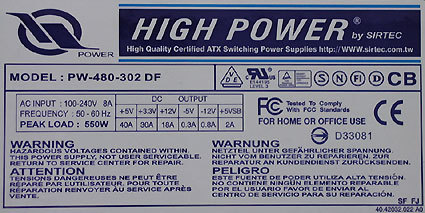Power Supplies Get Smarter
Power
Neither was the Power Watcher thrown by the benchmark marathon. The device can deliver the required 480 Watts without any problems, and the voltage fluctuations never go beyond the tolerances defined by the ATX specification. The maximum current of 18 A on the 12 Volt rail is a little on the weak side, particularly for the latest Pentium 4 processors featuring the Prescott core and power-hungry graphics cards. These devices require 12 Volts, and can present bottlenecks with this power supply. If the current is exceeded by only a minimal amount, the power supply switches off. For this power range, other manufacturers offer considerably higher currents on the 12 Volt rail.
Details on the power most definitively belong on this nameplate.
The efficiency of the device at full load is around 76%, which is a respectable value. At half load, this drops to 75%, at a low load it drops even further to a meager 69%.
With 10 Watts being drawn in standby mode at a low load and 19 Watts at a high load, this power supply is placed in the middle of the field.
The power meter in operation.
The power meter displays realistic values, even if these are slightly below the power output of the power supply. In standby mode, the display remains strictly at 2 Watts, as the actual consumption is not measured in this mode.
We currently have no details on the price for the Power Watcher.
Get Tom's Hardware's best news and in-depth reviews, straight to your inbox.

